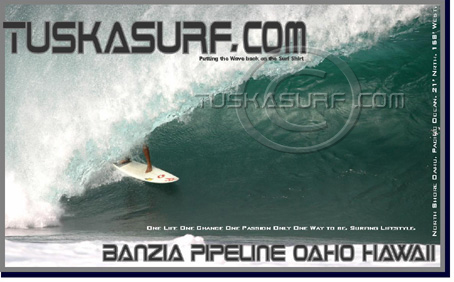
|
You
dont need a PayPal account
|
|
 |
|
SURFING BANZIA PIPELINE OAHU HAWAII

Code TS PIPELINE 3
|
The
Banzai Pipeline, or simply "Pipeline" or "Pipe,"
is a surf reef break located off Ehukai Beach Park in Pupukea
on O`ahu's North Shore. A reef break is an area in the ocean
where waves crash once they reach the shallows of a reef. Pipeline
is notorious and famous for its huge waves breaking in shallow
water just above its sharp and cavernous reef, forming large,
hollow and thick curls of water that surfers can surf inside.
There are three reefs at Pipeline in progressively deeper water
further out to sea that activate at various power levels applied
by ocean swells.
The location's compound name combines the name of the surf break (Pipeline) with the name of the beach fronting it (Banzai Beach). It got its name in December 1961 when surfing movie producer Bruce Brown was driving the North Shore with California surfers Phil Edwards and Mike Diffenderfer. Brown stopped at the then-unnamed site to film Edwards catching several waves. At the time, there was a construction project on an underground pipeline on adjacent Kamehameha Highway, and Diffenderfer made the suggestion to name the break Pipeline. The name was first used in Brown's movie Surfing Hollow Days. Pipeline is best on a strong swell that is pushed from the west, to clear out the sand in the reef that normally closes it out (meaning the hollow tube collapses all at once) on strong north swells. It is a flat tabletop reef, with several caverns on the inside, creating a giant air bubble that pops on the front of the wave when the wave lurches upwards just before breaking. There are also several jagged, underwater lava spires that can cut up fallen surfers fairly badly. There are four waves associated with Pipe. The left (which means the wave breaks from left to right from the perspective of a watcher on shore) known as Pipeline (a.k.a., First Reef), is the most commonly surfed and photographed. When the reef is hit by a north swell, the peak (the highest tipping-point of the wave where it begins to curl) becomes an A-frame shaped wave, with Pipe closing out a bit and peeling off left, and the just-as-famous Backdoor Pipeline peeling away to the right at the same time. As the size at Pipe increases, over 12 feet usually, Second Reef on the outside (further out into the deeper ocean waters) starts breaking, with longer walls (the steep, unbroken part of the wave that the surfer slides across), and more size. At an extreme size an area called Third Reef even further outside starts to break with giant waves. The extreme challenge posed by Pipeline at size, to even the best athletes, cannot be overstated. Numerous surfers and photographers have been killed at Pipe, including Jon Mozo and Tahitian Malik Joyeux, who was famous for his heavy charging (gutsy surfing) at Teahupo'o. Pipeline is often called the world's deadliest wave, since more people have died there, or have been seriously injured, than at any other surf spot. The takeoff zone at Pipeline is small but the number of surfers who flock there when it's breaking is large. Established local surfers consequently work together to limit outsiders' access to the waves. The localism and occasional violence of this self-described "Wolf Pack" (successors in this role to Da Hui) are often criticized, but their intimidating presence provides an indispensable degree of crowd control and has probably prevented even more carnage at Pipe. Among the many famous surfers to earn a reputation surfing the Pipeline are Butch Van Artsdalen, Gerry Lopez, Rory Russell, Shaun Tomson, Kane Quinn, Mark Richards, Michael Ho, Simon Anderson, Dane Kealoha, Tom Carroll, Gary Elkerton, Sunny Garcia, Kelly Slater, Jamie O'Brien, Rob Machado, Kala Alexander, Sunny Boy Gomes, Flynn Novak, John John Florence and bodyboarder Mike Stewart. Although not famous for surfing Pipeline, Jack Johnson's fame is partly because of surfing Pipeline. After a wipeout that put over£200 stitches in his forehead and knocked a few of his teeth out, his career path veered from becoming a professional surfer to becoming a musician. The top surfing competitions at this spot are the Pipe Masters (Board Surfing), the IBA Pipeline Pro (Bodyboarding), the and the Pipeline Bodysurfing Classic. As well as Shaun Tomson 1977 world champion from South Africa, and Mark Richards four time 1979-1982 world champion from Australia, surfers Wayne 'Rabbit' Bartholomew 1978 world champion from Australia and Peter Townen, 1976 world champion from Australia earned reputations surfing Off-The-Wall and Backdoor at a time when competitive surfing was coming of age. Off-The-Wall, and Backdoor are "the rights on the other side of Pipeline" - Randy Rarick, Director of Hawaiian Triple Crown of Surfing quoted from the movie "Bustin' Down The Door." |
Putting the wave back on the Surf shirt
SURFING PIPELINE HAWAII
Surf photo of Banzia Pipeline Hawaii,
|
Surf
Clothing from all over the World. Copyright © 2008 Tuska Surf
Co. All Rights Reserved
|






















